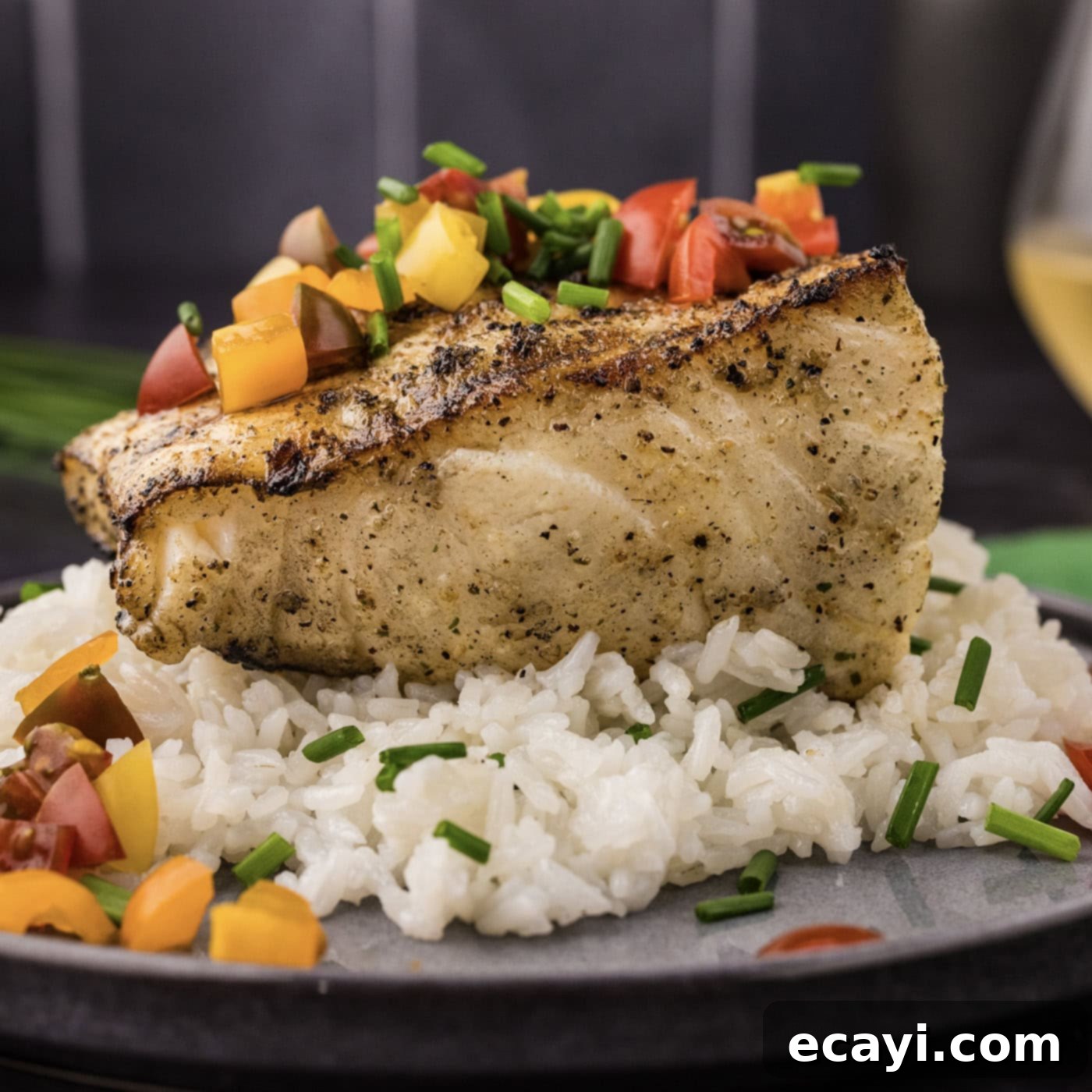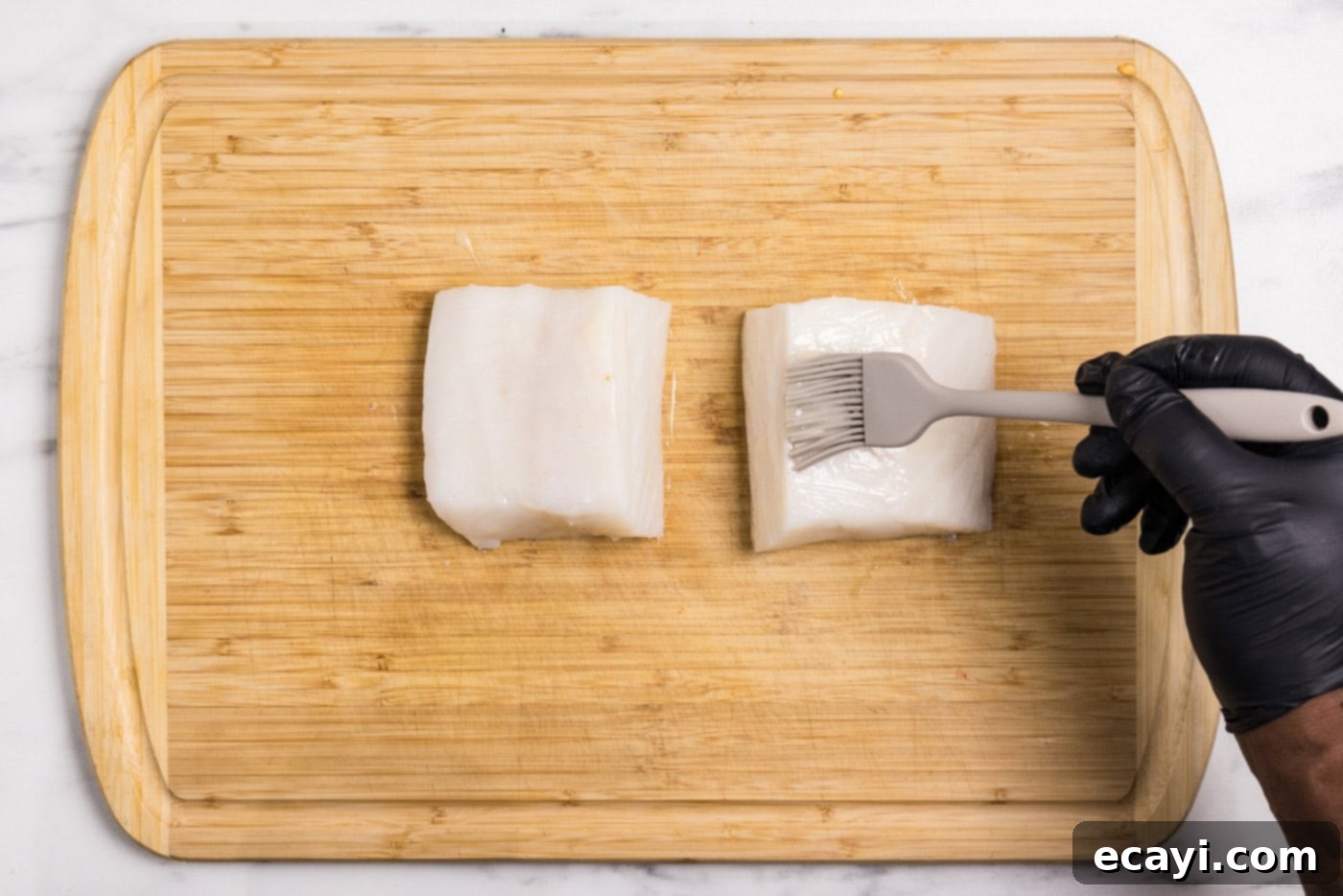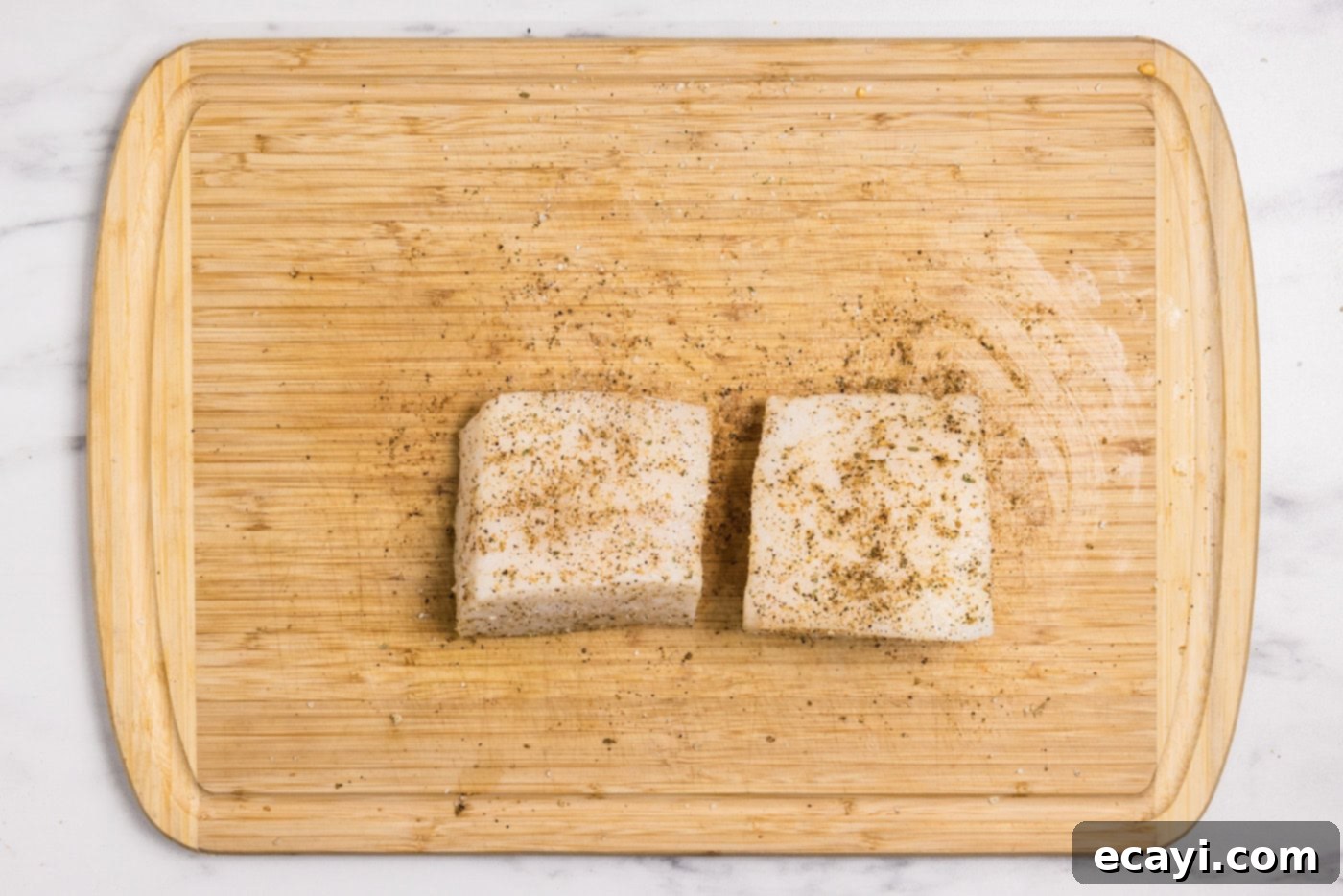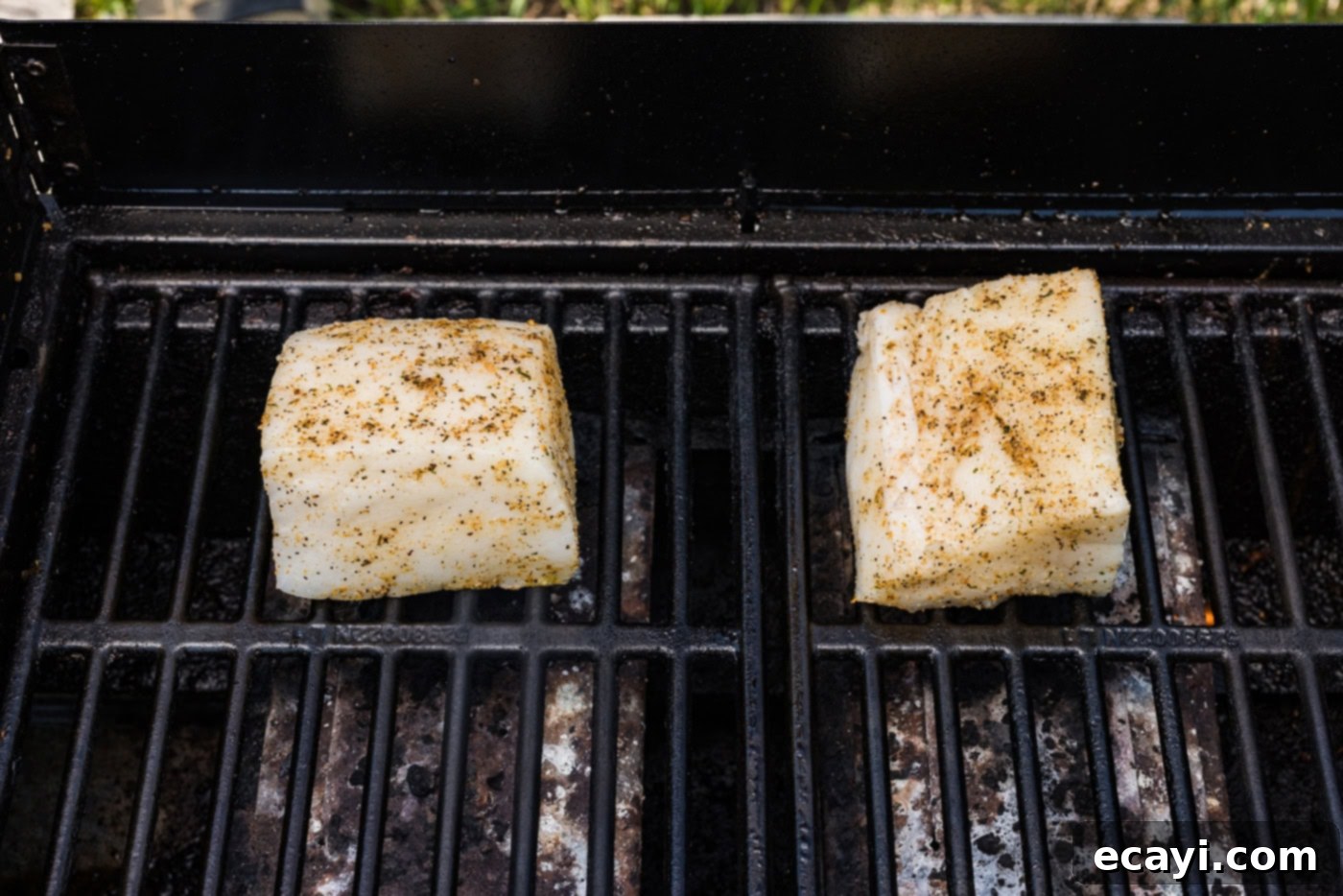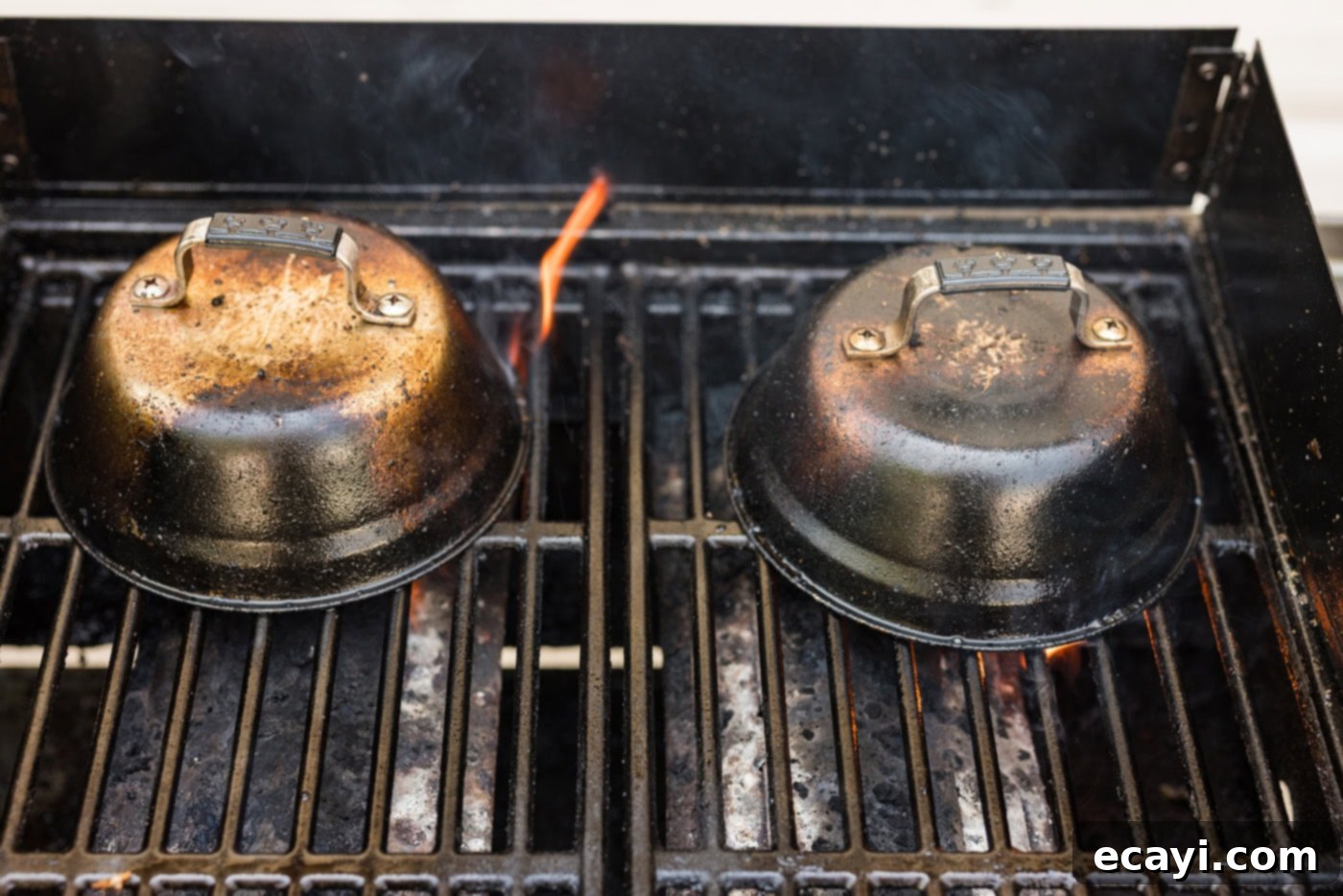Easy Grilled Chilean Sea Bass Recipe: Buttery, Flaky & Flavorful in Under 20 Minutes
Prepare to elevate your weeknight dinners or special occasions with this incredibly simple yet luxurious grilled Chilean sea bass recipe. Known for its rich, buttery flavor and delicate, flaky texture, Chilean sea bass is a premium choice that demands minimal effort to shine. This recipe focuses on enhancing its natural qualities with just four essential ingredients, plus the option of a vibrant, fresh mango salsa for a burst of complementary sweetness and acidity. You’ll be amazed at how quickly you can create an impressive, restaurant-quality seafood dish that will delight your taste buds and leave everyone craving more.
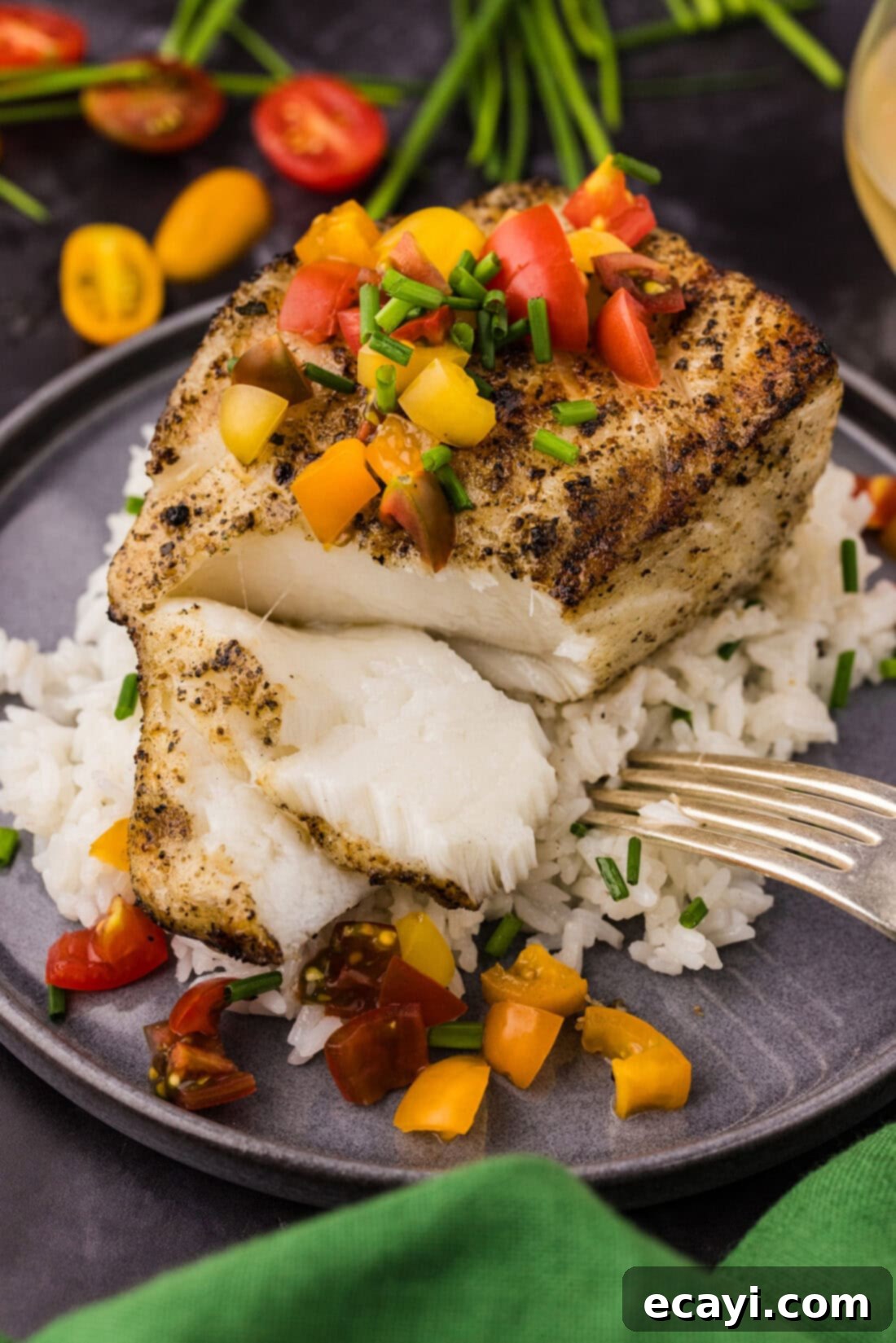
Why This Grilled Chilean Sea Bass Recipe is a Must-Try
Chilean sea bass, also known as Patagonian toothfish, holds a coveted spot in the culinary world for very good reasons. Its distinguishing characteristic is a high oil content, which translates into an inherently rich, buttery flavor and a famously melt-in-your-mouth texture. This natural abundance of oils makes it incredibly forgiving to cook; whether you choose to grill, pan-sear, or bake it, the fish remains wonderfully moist and tender. It’s genuinely challenging to overcook this fish, ensuring you achieve perfectly flaky, delicate results every single time.
The inherent deliciousness of Chilean sea bass means it doesn’t require complex marinades or heavy seasonings. Its natural profile is so robust and appealing that a minimalist approach truly allows its exquisite flavor to take center stage. While some might opt for an intricate spice rub, we believe a simple brush of melted butter paired with classic seasonings like Old Bay and garlic salt provides just the right amount of savory depth and aromatic warmth. This subtle enhancement complements the fish beautifully, without ever overshadowing its delicate essence. For an added layer of freshness and a touch of tropical brightness, an optional topping of vibrant mango salsa transforms this simple dish into an extraordinary culinary experience.
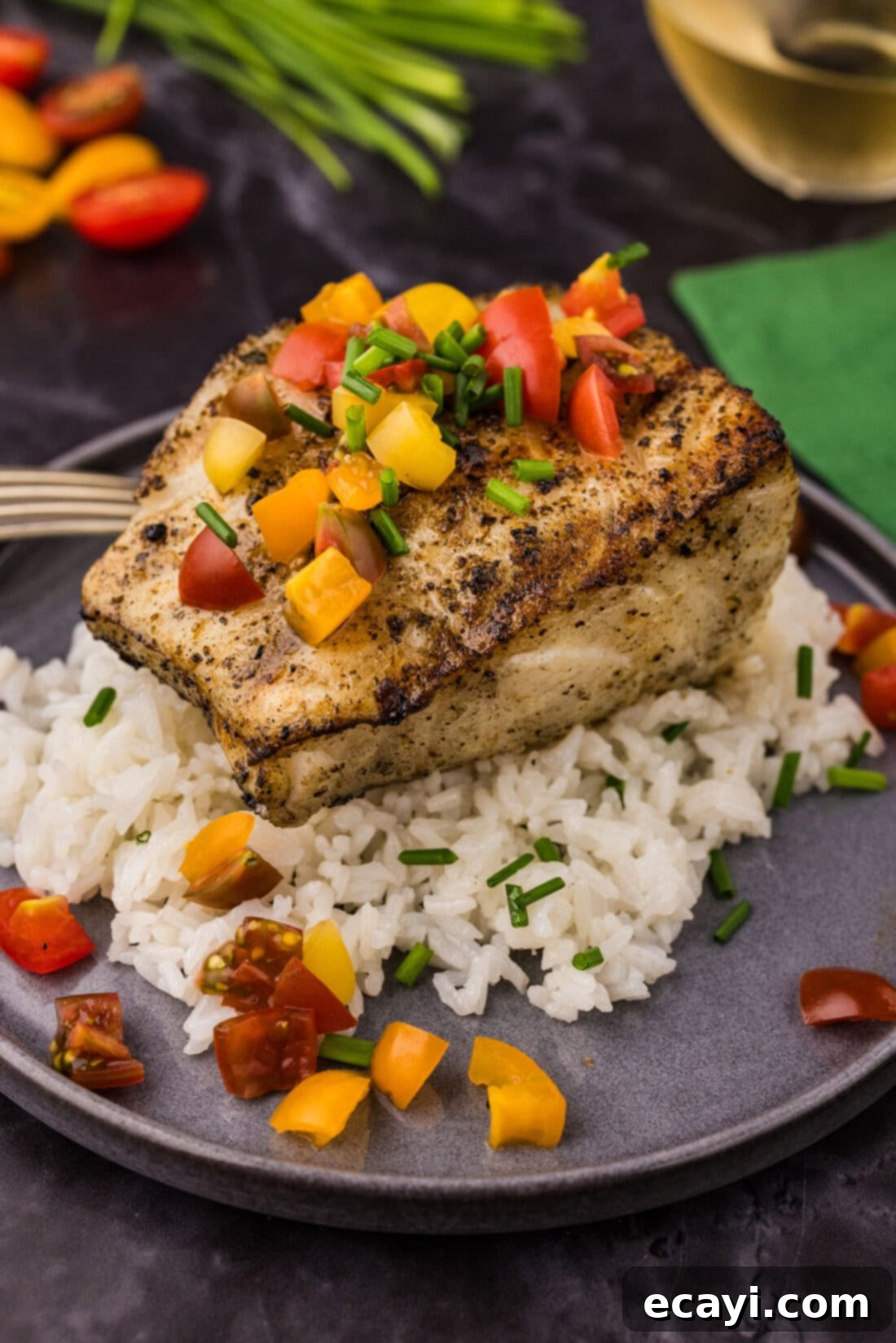
Essential Ingredients for Your Grilled Chilean Sea Bass
Crafting this elegant grilled fish dish requires only a handful of ingredients, allowing the natural flavor of the Chilean sea bass to truly shine. For precise measurements, detailed instructions, and a printable version of this recipe, please refer to the recipe card at the conclusion of this post. Here’s a closer look at what you’ll need to create this delectable meal:
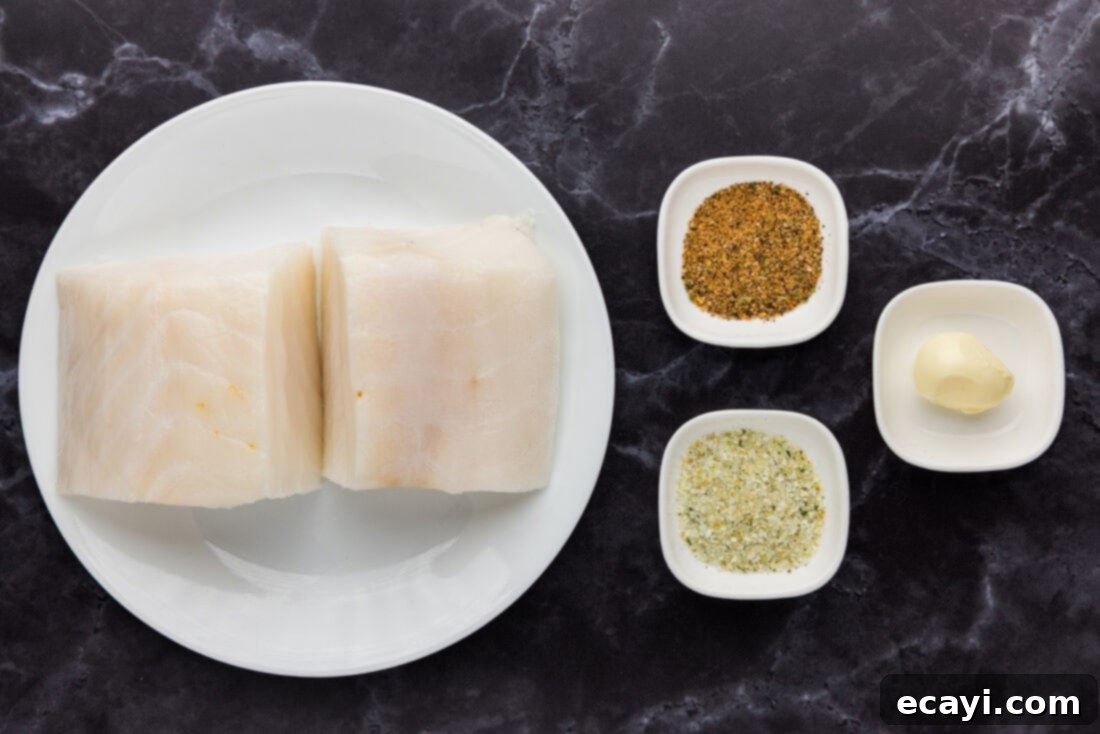
Ingredient Spotlight & Expert Substitution Tips
The Fish (Chilean Sea Bass): For this recipe, we highly recommend using the thickest part of the fish, often referred to as a “center cut” fillet. These thicker cuts tend to cook more evenly and retain moisture exceptionally well, yielding that desirable rich, buttery flakiness. When purchasing Chilean sea bass, you might encounter pieces closer to the tail, which are thinner. While still delicious, they may cook faster and require closer monitoring. Regardless of the cut, the key to perfect doneness isn’t just about cooking time, but rather the internal temperature. Always use a reliable meat thermometer to ensure your fish is cooked to perfection, reaching 140-145°F (60-63°C) for the best results. This prevents undercooking or drying out, guaranteeing a sublime texture every time.
The Seasoning (Old Bay & Garlic Salt): Chilean sea bass is inherently packed with flavor, so elaborate marinades and heavy spice blends are simply not necessary. Our chosen seasonings, Old Bay and garlic salt, are specifically selected to complement, rather than mask, the fish’s natural richness. Old Bay offers a classic seafood blend of savory spices with a hint of warmth, while garlic salt provides a foundational aromatic note. This minimalist approach allows the unique, buttery profile of the sea bass to truly shine through. Feel free to adjust the amounts to your taste, or even experiment with a squeeze of fresh lemon juice or a sprinkle of fresh parsley after grilling. However, remember the golden rule: this fish is magnificent on its own and requires very little to taste incredible!
Butter: Melted butter is crucial for both flavor and moisture retention. It creates a beautiful crust on the grill while keeping the fish incredibly succulent. You can use unsalted or salted butter; just adjust the garlic salt amount accordingly. For a dairy-free alternative, olive oil or avocado oil can be used, though they will impart a slightly different flavor profile than butter.
Step-by-Step Guide: How to Grill Chilean Sea Bass to Perfection
These step-by-step photos and instructions are here to help you visualize how to make this recipe successfully. For the full printable version of this recipe, complete with precise measurements and detailed instructions, please Jump to Recipe at the bottom of this post.
- Preheat Your Grill: Begin by preheating your grill to a consistent 375°F (190°C). Allow the grates to get thoroughly hot before placing the fish on them. This ensures a beautiful sear and prevents sticking, which is crucial for delicate fish.
- Butter the Fillets: Using a basting brush, generously brush both sides of your Chilean sea bass fillets with melted butter. This not only adds incredible flavor but also helps create a golden crust and keeps the fish moist throughout the grilling process.

- Season Generously: Season all sides of the buttered fillets with Old Bay seasoning and garlic salt. Ensure an even coating for balanced flavor in every bite. This simple seasoning blend truly enhances the fish without overpowering it.

- Initial Grill Placement: Carefully place the seasoned fillets directly onto the hot grill grates. Let them cook undisturbed for a couple of minutes to allow a beautiful crust to develop. This initial sear is vital for flavor and texture.

- Cover and Cook: Place a basting cover (or an oven-safe dome lid) over each fillet. This helps trap heat and moisture, allowing the fish to cook through gently while retaining its juiciness. Cook for 3-5 minutes on the first side. If you don’t have basting covers, you can close the grill lid, but keep a close eye on the temperature.

- Flip and Finish: Remove the basting covers and carefully flip the fillets over. Replace the covers and continue to cook for an additional 3-5 minutes, or until the internal temperature of the thickest part of the fish reaches 140-145°F (60-63°C). Once cooked, remove from the grill and let rest for a few minutes to allow the juices to redistribute, resulting in an even more tender and flavorful fish.
Frequently Asked Questions & Expert Tips for Grilling Fish
For the absolute best flavor and texture, Chilean sea bass should be cooked to an internal temperature of 145°F (62°C). I typically recommend removing the fish from the grill when it reaches about 140°F (60°C). This allows for carryover cooking during the resting period, ensuring it reaches the perfect 145°F and stays incredibly moist. Always use a high-quality instant-read meat thermometer inserted into the thickest part of the fillet. Relying solely on visual cues or estimated cooking times can be misleading, as fillet thickness and grill temperatures vary greatly.
If you happen to have any leftovers (it’s rare with this delicious fish!), allow the grilled Chilean sea bass to cool completely before transferring it to an airtight container. Store it in the refrigerator for up to 2-3 days. To reheat, gently warm the fish in a skillet over low heat with a small pat of butter or a splash of broth. Be careful not to overheat, as this can dry out the delicate fish. You can also briefly warm it in a microwave at a low setting, but the stovetop method generally yields better results for maintaining texture.
Absolutely! Chilean sea bass is wonderfully versatile. If grilling isn’t an option or you prefer a different cooking style, you can definitely prepare it in the oven or on the stovetop. For detailed instructions on oven preparation, hop over to our dedicated baked Chilean sea bass recipe. We also have a fantastic guide for pan-searing Chilean sea bass, which creates a beautifully crispy exterior while keeping the interior moist and tender. Each method brings out slightly different nuances of the fish’s flavor and texture, but all are equally delicious.
Basting covers, often dome-shaped metal lids, are a fantastic tool for grilling delicate foods like fish. They create a mini-oven effect directly on the grill, trapping heat and steam around the fillet. This helps the fish cook more evenly, remain incredibly moist, and prevents it from drying out on the hotter grill grates. They also aid in developing a beautiful, gentle crust without overcooking the interior. If you don’t have specific basting covers, any oven-safe dome or even aluminum foil tented over the fish can provide a similar, albeit less effective, result.
This recipe can be successfully made on various types of grills, including gas, charcoal, or even an indoor electric grill. The key is to ensure consistent, medium-high heat (around 375°F / 190°C) and clean, well-oiled grates to prevent sticking. Gas grills offer easy temperature control, while charcoal grills impart a wonderful smoky flavor. Whichever you choose, always preheat your grill thoroughly and clean the grates before use for the best grilling experience with delicate fish.
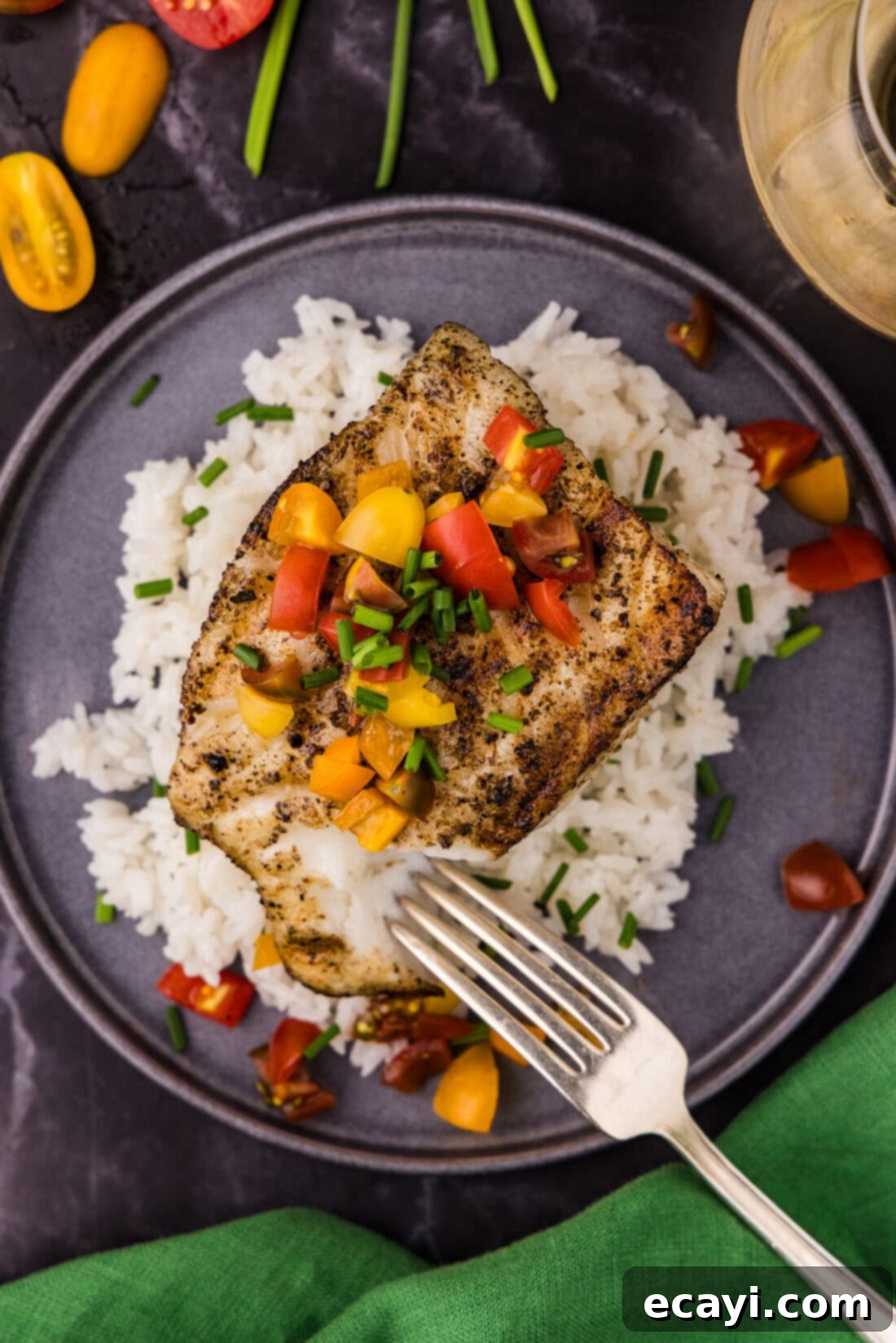
Elevate Your Meal: Delicious Serving Suggestions
The mild yet rich flavor of Chilean sea bass makes it an incredibly versatile protein that pairs beautifully with a wide array of side dishes. For a light and refreshing meal, serve it over a bed of fluffy white rice, complemented by a vibrant fresh mango salsa or a zesty pineapple salsa. The tropical fruit notes provide a delightful contrast to the fish’s buttery profile. Alternatively, a herbaceous chimichurri sauce can add a bright, garlicky kick that’s utterly irresistible.
Beyond rice, this grilled sea bass is excellent alongside creamy mashed potatoes, a healthy quinoa salad, or a medley of roasted seasonal vegetables such as asparagus, broccoli, or bell peppers. For a Mediterranean touch, consider serving it with a lemon-herb couscous. If you’re looking for a low-carb option, cauliflower rice or a simple mixed green salad with a light vinaigrette would be perfect. A crisp white wine, like a Sauvignon Blanc or a Pinot Grigio, would also beautifully complement the flavors of this exquisite dish.
This recipe, with its emphasis on simple preparation and exceptional flavor, truly stands out as one of my favorites. Its rich, delicate texture and inherent deliciousness make it a dish you’ll want to revisit again and again, no matter how you choose to serve it. I sincerely hope you and your loved ones enjoy this grilled Chilean sea bass as much as we do!
Explore More Irresistible Fish Recipes
If you loved this grilled Chilean sea bass, you’re in for a treat! Discover more fantastic fish recipes that are easy to prepare and packed with flavor:
- Smoked Trout
- Maple Soy Salmon
- Grilled Mahi Mahi
- Baked Orange Roughy
I love to bake and cook and share my kitchen experience with all of you! Remembering to come back each day can be tough, that’s why I offer a convenient newsletter every time a new recipe posts. Simply subscribe and start receiving your free daily recipes!
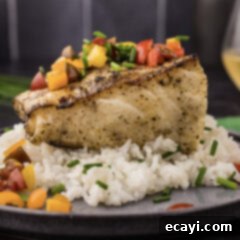
Grilled Chilean Sea Bass
IMPORTANT – There are often Frequently Asked Questions within the blog post that you may find helpful. Simply scroll back up to read them!
Print It
Pin It
Rate It
Save ItSaved!
Ingredients
- 1 pound center cut Chilean sea bass 453g, 16 ounces
- 1 Tablespoon butter melted
- 1 teaspoon Old Bay seasoning
- 1 teaspoon garlic salt
Optional Garnish
- chopped chives
- mango salsa
Things You’ll Need
-
Grill
-
Basting brush
-
Basting covers
-
Instant read thermometer
Before You Begin
- For the ultimate experience, choose a thick, center-cut portion of Chilean sea bass. While all cuts are delicious, thicker fillets cook more uniformly and remain incredibly moist. Be mindful that thinner, tail-end pieces may cook faster.
- The most accurate way to ensure your Chilean sea bass is perfectly cooked is by using a reliable meat thermometer. Target an internal temperature of 145°F (62°C) in the thickest part of the fish. I recommend removing it from the heat when it hits 140°F (60°C) and letting it rest for a few minutes; residual heat will bring it to the perfect final temperature. This method is far more dependable than relying on visual cues or estimated cooking times.
Instructions
-
Preheat your grill to a consistent 375°F (190°C). Ensuring the grates are very hot is key for a good sear and to prevent sticking.
-
Brush all sides of the Chilean sea bass fillets generously with melted butter. This adds flavor and helps with browning.1 Tablespoon butter, 1 pound center cut Chilean sea bass
-
Season all sides of the buttered fillets evenly with Old Bay seasoning and garlic salt.1 teaspoon Old Bay seasoning, 1 teaspoon garlic salt
-
Carefully place the seasoned fillets onto the preheated grill. Allow them to cook for a couple of minutes undisturbed to develop a beautiful initial crust.
-
Place a basting cover over each fillet to trap heat and moisture, then cook for 3-5 minutes.
-
Remove the basting covers, flip the fillets gently, and replace the covers. Continue cooking for an additional 3-5 minutes, or until an instant-read thermometer inserted into the thickest part reads 140-145°F (60-63°C). Rest for a few minutes before serving for optimal juiciness.
Expert Tips & FAQs
- To ensure your grilled sea bass remains delicious, store any cooled leftovers in an airtight container in the refrigerator for up to 2-3 days. Reheat gently in a skillet over low heat with a touch of butter or broth until just warmed through to avoid drying out the delicate fish.
- Always use a reliable instant-read thermometer to check the internal temperature of the fish. This is the most accurate way to ensure perfect doneness and avoid overcooking, which can quickly turn delicate fish dry.
- Don’t overcrowd the grill. Cook in batches if necessary to maintain consistent grill temperature and ensure proper searing.
- If you don’t have basting covers, closing the grill lid after placing the fish will help cook it more evenly, though you’ll need to monitor internal temperatures carefully.
Nutrition Information
The recipes on this blog are tested with a conventional gas oven and gas stovetop. It’s important to note that some ovens, especially as they age, can cook and bake inconsistently. Using an inexpensive oven thermometer can assure you that your oven is truly heating to the proper temperature. If you use a toaster oven or countertop oven, please keep in mind that they may not distribute heat the same as a conventional full sized oven and you may need to adjust your cooking/baking times. In the case of recipes made with a pressure cooker, air fryer, slow cooker, or other appliance, a link to the appliances we use is listed within each respective recipe. For baking recipes where measurements are given by weight, please note that results may not be the same if cups are used instead, and we can’t guarantee success with that method.
